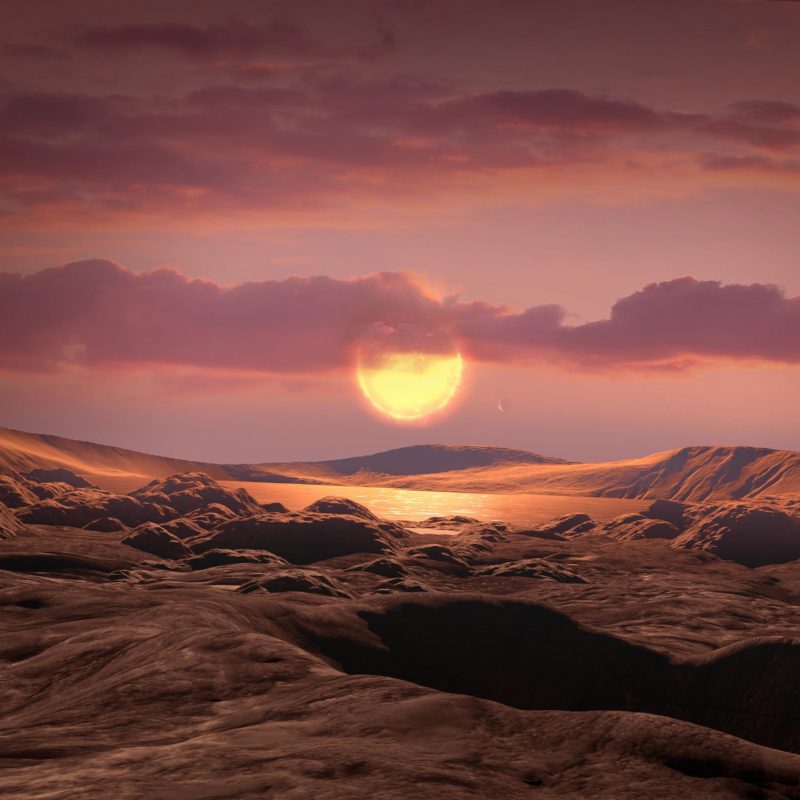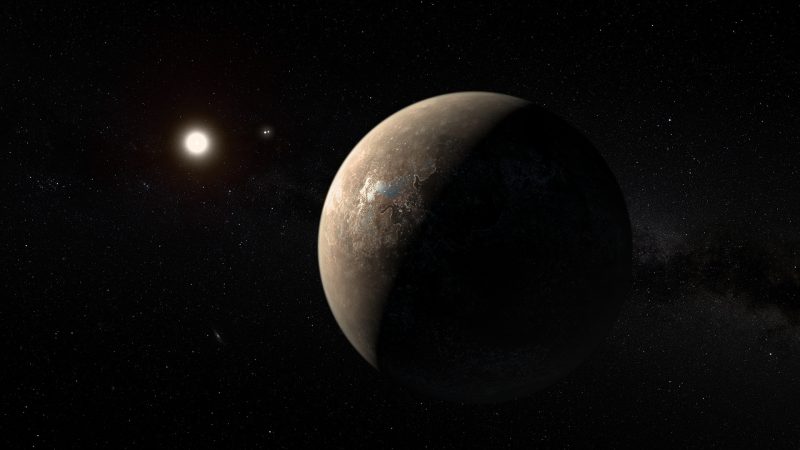
The number of known exoplanets – planets orbiting other stars – has just leapt up again. In fact, we know over 5,000 confirmed exoplanets to date, with a few thousand more candidates. This month (February 22, 2023), astronomers in Spain and Germany said they’ve found and confirmed 59 new worlds. All of them are relatively nearby, within about 65 light-years of our sun and its family of planets. The astronomers based the new work on 20,000 observations of 362 nearby stars.
All of the new-found planets orbit red dwarf stars. And 12 of the them are potentially habitable, the researchers said.
The astronomers are with the CARMENES project consortium, which just released its first dataset (Data Release 1). The journal Astronomy & Astrophysics published the new peer-reviewed paper on February 22. A preprint of the paper is also available on arXiv.
59 new exoplanets in the solar neighborhood
CARMENES is the name of both the survey project … and the scientific instrument used. The CARMENES survey focuses on rocky planets similar to Earth, including Earth-sized and super-Earths.
The CARMENES scientific instrument is installed on the Calar Alto Observatory in Spain. It uses Doppler spectroscopy (aka the tried-and-true radial velocity method) for finding exoplanets.
They conducted the observations between 2016 and 2020.
According to the latest data release, astronomers say CARMENES has discovered 59 new exoplanets altogether. Altogether, this includes six Jupiter-like planets (with masses more than 50 times that of the Earth), 10 Neptune-like planets (10 to 50 Earth masses) and 43 Earths and super-Earths (up to 10 Earth masses). Intriguingly, 12 of these planets are potentially habitable for life of some kind, the astronomers say. In addition, at least eight of the Earth and super-Earth-sized planets are in the habitable zone of their stars, with a ninth right on the edge. By the way, the habitable zone is the region where temperatures on rocky planets could allow liquid water to exist.
The sample of stars used in the study includes 15% of all known red dwarfs out to a distance of 20 parsecs (65 light-years) and 48% at 10 parsecs (33 light-years).
Also, in addition to the 59 new planets, CARMENES also re-analyzed 17 previously known planets.
Lead author Ignasi Ribas at the Institute of Space Sciences (IEEC-CSIC) stated:
Since it came into operation, CARMENES has reanalyzed 17 known planets and has discovered and confirmed 59 new planets in the vicinity of our solar system, contributing notably to expanding the census of nearby exoplanets.
CARMENES includes more than 200 scientists and engineers from 11 Spanish and German institutions.
Re-observing the same stars
The CARMENES project, now known as CARMENES Legacy-Plus, began in 2021. In order to confirm new planets as accurately as possible, it continues to re-observe the same stars at least 50 times. As Juan Carlos Morales, IEEC researcher at ICE-CSIC, explained:
In order to determine the existence of planets around a star, we observe it a minimum of 50 times. Although the first round of data has already been published so that the scientific community can access them, the observations are still ongoing.

High-resolution spectra
CARMENES studies the stars and their planets in both visible (optical) and infrared light. Astronomers can detect planets orbiting the stars by analyzing the light from the star. They do this by measuring the tiny motions of the star – the radial velocity method – produced by the planets “tugging” on them with their gravitational pull. Incredibly, astronomers can determine the velocity of the star with an accuracy of one meter per second. In this way, they can detect smaller rocky planets, something that is typically difficult.
Additionally, the high-resolution spectra can also provide clues as to the what kinds of atmospheres the planets have, if any. Pedro J. Amado at the Institute of Astrophysics of Andalusia (IAA-CSIC) said:
In addition to the scientific project, from the IAA-CSIC, and in close collaboration with the technicians and engineers of the Calar Alto Observatory, we are developing a technical improvement to provide more precision to the entire instrument, and in particular to the infrared channel. Called CARMENES-PLUS, this instrumental project will allow CARMENES to maintain its high competitiveness, not only broadening its search for rocky planets but also allowing the characterization of their possible atmospheres, which constitutes the next observational challenge in the field.
In this current data release, the researchers published the visible light data. Later, the infrared data will also be published. That data is still being processed.
Bottom line: Astronomers in Europe have discovered 59 new exoplanets orbiting red dwarf stars. Twelve are potentially habitable. They all lie within 65 light-years of our sun.
Via Institute of Astrophysics of Andalusia (IAA-CSIC)
Via Institute of Spatial Studies of Catalonia (IEEC)
The post 59 new exoplanets discovered around nearby stars first appeared on EarthSky.
from EarthSky https://ift.tt/DjI8Ynx

The number of known exoplanets – planets orbiting other stars – has just leapt up again. In fact, we know over 5,000 confirmed exoplanets to date, with a few thousand more candidates. This month (February 22, 2023), astronomers in Spain and Germany said they’ve found and confirmed 59 new worlds. All of them are relatively nearby, within about 65 light-years of our sun and its family of planets. The astronomers based the new work on 20,000 observations of 362 nearby stars.
All of the new-found planets orbit red dwarf stars. And 12 of the them are potentially habitable, the researchers said.
The astronomers are with the CARMENES project consortium, which just released its first dataset (Data Release 1). The journal Astronomy & Astrophysics published the new peer-reviewed paper on February 22. A preprint of the paper is also available on arXiv.
59 new exoplanets in the solar neighborhood
CARMENES is the name of both the survey project … and the scientific instrument used. The CARMENES survey focuses on rocky planets similar to Earth, including Earth-sized and super-Earths.
The CARMENES scientific instrument is installed on the Calar Alto Observatory in Spain. It uses Doppler spectroscopy (aka the tried-and-true radial velocity method) for finding exoplanets.
They conducted the observations between 2016 and 2020.
According to the latest data release, astronomers say CARMENES has discovered 59 new exoplanets altogether. Altogether, this includes six Jupiter-like planets (with masses more than 50 times that of the Earth), 10 Neptune-like planets (10 to 50 Earth masses) and 43 Earths and super-Earths (up to 10 Earth masses). Intriguingly, 12 of these planets are potentially habitable for life of some kind, the astronomers say. In addition, at least eight of the Earth and super-Earth-sized planets are in the habitable zone of their stars, with a ninth right on the edge. By the way, the habitable zone is the region where temperatures on rocky planets could allow liquid water to exist.
The sample of stars used in the study includes 15% of all known red dwarfs out to a distance of 20 parsecs (65 light-years) and 48% at 10 parsecs (33 light-years).
Also, in addition to the 59 new planets, CARMENES also re-analyzed 17 previously known planets.
Lead author Ignasi Ribas at the Institute of Space Sciences (IEEC-CSIC) stated:
Since it came into operation, CARMENES has reanalyzed 17 known planets and has discovered and confirmed 59 new planets in the vicinity of our solar system, contributing notably to expanding the census of nearby exoplanets.
CARMENES includes more than 200 scientists and engineers from 11 Spanish and German institutions.
Re-observing the same stars
The CARMENES project, now known as CARMENES Legacy-Plus, began in 2021. In order to confirm new planets as accurately as possible, it continues to re-observe the same stars at least 50 times. As Juan Carlos Morales, IEEC researcher at ICE-CSIC, explained:
In order to determine the existence of planets around a star, we observe it a minimum of 50 times. Although the first round of data has already been published so that the scientific community can access them, the observations are still ongoing.

High-resolution spectra
CARMENES studies the stars and their planets in both visible (optical) and infrared light. Astronomers can detect planets orbiting the stars by analyzing the light from the star. They do this by measuring the tiny motions of the star – the radial velocity method – produced by the planets “tugging” on them with their gravitational pull. Incredibly, astronomers can determine the velocity of the star with an accuracy of one meter per second. In this way, they can detect smaller rocky planets, something that is typically difficult.
Additionally, the high-resolution spectra can also provide clues as to the what kinds of atmospheres the planets have, if any. Pedro J. Amado at the Institute of Astrophysics of Andalusia (IAA-CSIC) said:
In addition to the scientific project, from the IAA-CSIC, and in close collaboration with the technicians and engineers of the Calar Alto Observatory, we are developing a technical improvement to provide more precision to the entire instrument, and in particular to the infrared channel. Called CARMENES-PLUS, this instrumental project will allow CARMENES to maintain its high competitiveness, not only broadening its search for rocky planets but also allowing the characterization of their possible atmospheres, which constitutes the next observational challenge in the field.
In this current data release, the researchers published the visible light data. Later, the infrared data will also be published. That data is still being processed.
Bottom line: Astronomers in Europe have discovered 59 new exoplanets orbiting red dwarf stars. Twelve are potentially habitable. They all lie within 65 light-years of our sun.
Via Institute of Astrophysics of Andalusia (IAA-CSIC)
Via Institute of Spatial Studies of Catalonia (IEEC)
The post 59 new exoplanets discovered around nearby stars first appeared on EarthSky.
from EarthSky https://ift.tt/DjI8Ynx

Aucun commentaire:
Enregistrer un commentaire